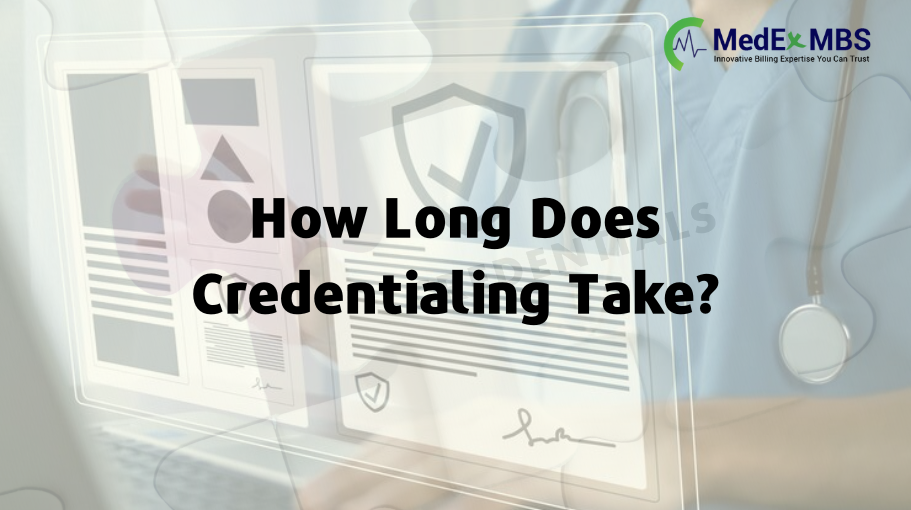How Long Does Credentialing Take?

If you operate a healthcare practice, you are likely well-acquainted with the various components of the healthcare system and its processes. Some of these components occur rapidly, while others may take longer to develop. Credentialing represents a vital and important phase in the onboarding procedure for healthcare professionals. This process is also referred to as provider credentialing, medical credentialing, and physician credentialing. It entails a thorough verification of healthcare providers to confirm that they fulfill the necessary criteria for delivering quality services. However, it is important to note that this process can be quite time-consuming and may require more time than healthcare providers typically anticipate. If you are interested in understanding the duration of the credentialing process and the primary factors that may cause delays in provider credentialing, we encourage you to read this article. Additionally, you will discover effective strategies to enhance the efficiency of the credentialing process. Let us begin! What is the typical duration required to credential a provider? Physician credentialing provides numerous advantages for both patients and healthcare providers. This process ensures that all professional credentials are accurately verified, allowing patients to receive high-quality care. Credentialing specialists are also capable of identifying fraudulent credentials, thereby preserving the integrity of a healthcare practice. Furthermore, a more expedited credentialing process enables patients to access the quality care they desire without unnecessary delays. Ultimately, this efficiency allows healthcare providers to receive their reimbursements promptly. Typically, the entire procedure can take several weeks to months to finalize the credentials for healthcare providers. Typically, the duration for provider credentials averages between 90 and 120 days. However, it is important to note that this is merely an average estimate. The precise duration of a provider’s credential is contingent upon several factors, including: The efficiency of the organization’s credentialing process The accuracy and effectiveness of provider documentation The complexity of the provider’s background The method of credential Generally, the anticipated approval times for credentials are as follows: Credentialing for Medicare and Medicaid: 60 to 90 days NPI application: 30 minutes Initial versus re-credentialing times: 90 to 150 days / 45 to 90 days Commercial insurance carrier credentialing: 60 to 90 days (30 days for contracting) Online CAQH application: 3 hours The provider credentialing process should ideally be expedited. If healthcare providers are solely focused on credentials, they may neglect their patients. This can adversely affect the revenue stream of a healthcare organization. If healthcare providers do not meet the credentialing requirements for approval, they will be unable to offer their services. Consequently, the healthcare organization will miss out on the benefits of its professional expertise. Therefore, the medical credentialing process must be efficient and effective, enabling healthcare providers to reach their objectives. What documents are necessary for Credentialing? The initial phase of credentialing healthcare providers entails the verification of all documents submitted by these providers. Credentials specialists are tasked with this responsibility and meticulously review each document. They also conduct primary source verification to ensure accurate assessment. During this initial phase, the following documents are verified as they are crucial for the credentials process. Application The initial application serves as a form that collects all pertinent information, including personal details such as contact information and other background specifics. The processing time for credentialing applications can vary. Education Providers must submit documentation of their educational qualifications, including certificates, diplomas, and similar credentials. Personal identification This category includes the passport, driver’s license, and social security number. Professional documents This encompasses board certificates, medical licenses, and associated registrations, among others. Previous work history Providers are also required to furnish details regarding their past responsibilities, including affiliations with professional organizations, employment dates, and job descriptions. Malpractice insurance Alongside the documents, providers are required to submit proof of malpractice insurance coverage. DEA registration If healthcare providers prescribe controlled substances, they must submit their registration details to the Drug Enforcement Administration (DEA). Criminal record Credential professionals also investigate whether there is any criminal record associated with a provider to avert potential issues in the future. What are the primary steps involved in the credentialing of providers? The primary steps in the credential process are outlined as follows: Information Gathering The initial step entails the collection of the necessary credentials for credential. Comprehensive information regarding healthcare providers is compiled. Additionally, other pertinent details include the physical address, mailing address, individual or group National Provider Identifier (NPI), clinic fax number, Tax Identification Number, Master Provider Index, and so forth. The duration of this step can vary, but it typically spans a few weeks. Creation of a Payer List The subsequent step involves formulating a list of payers and insurance networks with which you intend to contract or participate in their insurance plans. The choice of insurance networks is determined by the preferences and requirements of the healthcare practice. Government Health Plans This includes TRICARE, Medicaid, Medicare, the Children’s Health Insurance Program (CHIP), and VA Health Care. Health Insurance Right Health United Healthcare Cigna Humana Anthem Kaiser Permanente Blue Cross Blue Shield Bright Health Aetna Oscar Health Sidecar Health Lemonade Development of CAQH Profile The CAQH (Council for Affordable Quality Healthcare) is a database that authenticates provider information. Initially, a CAQH profile is established and subsequently maintained. Creating a CAQH profile is highly advantageous as it enables one to apply for credentials at multiple organizations simultaneously. State credentialing application Some credential applications are specific to states and gather information related to education, training, experience, and licensure. Determining the payer’s credentialing requirements The initial step you should undertake before commencing your application process is to ascertain how many payers you wish to collaborate with. Additionally, you should identify the requirements of each payer. By accessing their official website, you can ascertain all specific requirements. Subsequently, you can submit your application accurately. Submission of application Once you have compiled a list of payers and identified their requirements,
